One Picture-Book Roundtable Discussion Before Breakfast #4: Featuring the Women of Finding Winnie
 September 22nd, 2015 by jules
September 22nd, 2015 by jules
I felt a little bereft when it was all done.”
(Click to enlarge)
Back in the day, I used to do what I called picture-book roundtable discussions here at 7-Imp — in which the author, illustrator, editor, and art director/book designer would join me to give readers varying perspectives on one picture book title. I’ve only done three of these, though I really do enjoy them, and the last one was back in 2011. Wow. It’s been a while.
But I’m happy to be doing it again today with such an impressive book in the spotlight. That book is Lindsay Mattick’s Finding Winnie: The True Story of the World’s Most Famous Bear, illustrated by Sophie Blackall. It’ll be on shelves next month from Little, Brown.
Mattick is the great-granddaughter of Harry Colebourn, the World War I veterinarian who rescued a baby bear cub in 1914 — and named that bear Winnipeg (“Winnie” for short). It’s this cub that caught the eye of Christopher Robin Milne at the London Zoo and inspired the character of Winnie-the-Pooh.
Mattick’s story is framed with her, as a mother, telling her son Cole (named after Harry Colebourn) this family story. Her writing is superb. As the Publishers Weekly review notes, it strikes a “lovely, understated tone of wonder ….” Sophie Blackall’s illustrations are detailed and well-researched (as you’ll read below) — and they sing with a reverence for the subject matter. Oh, and lots of warmth.
Both author and illustrator, as well as Little, Brown editor Susan Rich and art director Saho Fujii, join me today to talk about the book, and Sophie shares some images and art too. I thank all these ladies for stopping by to give me and 7-Imp readers another glimpse into the picture-book process, and I turn the table over to them now.
7-Imp: What was your first impression or reaction to the Finding Winnie manuscript? (Lindsay, you can simply address the writing of it, getting the initial idea for it, etc.)
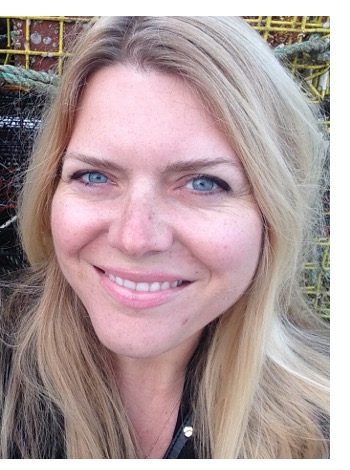 Lindsay (pictured left):
Lindsay (pictured left):
I first had the idea to tell my family story as a children’s book about a decade ago but then got distracted with other projects. When I found out I was pregnant with my son, I felt an immediate sense of urgency. (Dare I say panic?)
I remember sitting down with my laptop to write in a café in Costa Rica, and what came out first was the book’s now dedication to my son. While I didn’t know it at the time, that dedication would shape the narrative of what became Finding Winnie.
I was also very inspired by a book called Polar the Titanic Bear about a stuffed bear that traveled on the Titanic. I loved the way the story was intertwined with old photographs and material. I knew that I wanted to share our family’s amazing photographs of Harry and Winnie in the book to remind children just how real and beautiful this story truly is.
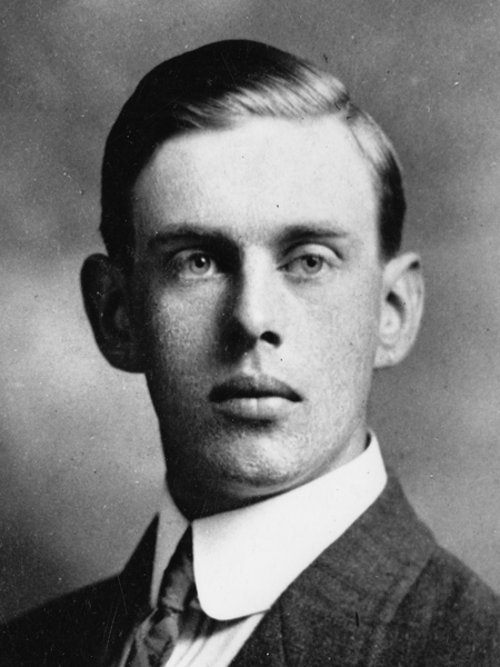

 Sophie (pictured right): Susan Rich sent me a very winning email with the manuscript attached, and in spite of having made myself a stern promise not to take on any new manuscripts, no matter how tempting, I read it and it gave me goosebumps. As I wrote back to Susan, I lived Winnie-the-Pooh when I was young—I spent most of my childhood up a tree with my bear—and it was E.H. Shepard who made me want to be an illustrator in the first place. Winnie-the-Pooh was the first book I bought with my own money (a battered old edition), and I had just picked up Christopher Robin’s memoir the very weekend I received Lindsay’s manuscript, so everything felt meant-to-be.
Sophie (pictured right): Susan Rich sent me a very winning email with the manuscript attached, and in spite of having made myself a stern promise not to take on any new manuscripts, no matter how tempting, I read it and it gave me goosebumps. As I wrote back to Susan, I lived Winnie-the-Pooh when I was young—I spent most of my childhood up a tree with my bear—and it was E.H. Shepard who made me want to be an illustrator in the first place. Winnie-the-Pooh was the first book I bought with my own money (a battered old edition), and I had just picked up Christopher Robin’s memoir the very weekend I received Lindsay’s manuscript, so everything felt meant-to-be.
That, and as Susan said in her email, the story was full of wonderful things to draw: a sea of white tents at the army barracks, a parade of ships crossing the ocean in 1914, The London Zoo. …

Susan (pictured below): I thought, “It’s meant to be!”
Like Lindsay, I am from Winnipeg, and the story of my hometown’s connection with Winnie-the-Pooh is in the air there. I went on to study Children’s Literature at McGill University and then at Simmons College, which often brought me back to the beautiful work of A. A. Milne and E.H. Shepard. Finding Winnie celebrates the incredible legacy of Captain Colebourn following his heart; the making of this book feels like the literary culmination of following my own.
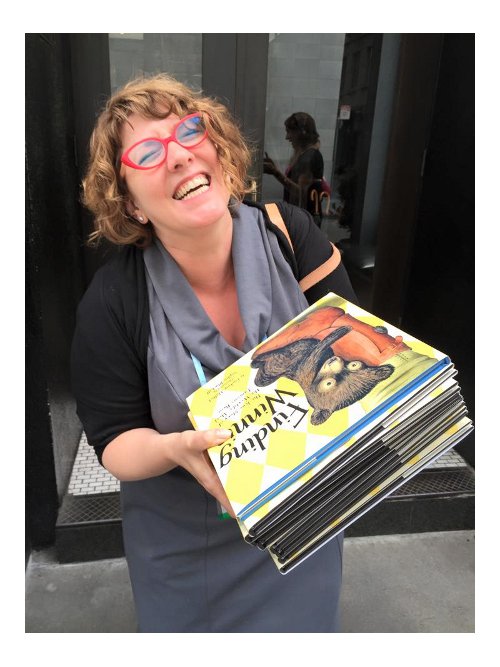
Saho (pictured below): Winnie-the-Pooh was a bear!
I never knew Winnie was inspired by a real girl bear and how she came to inspire Alan Alexander Milne’s books. You don’t need to be a fan of Winnie-the-Pooh to read this book. I actually never read his books as a child. (I grew up in Japan, and Winnie-the-Pooh was not as popular/known, as he was here in the U.S.). However, I immediately fell in love with Winnipeg, just as Harry and Christopher did.
I love true stories and learning about things I didn’t know through stories. This is one remarkable true story of friendship, love, and history that kids (and adults!) will definitely appreciate.
7-Imp: Describe a part of the Finding Winnie process that was challenging or surprising (or both).
Lindsay: Finding Winnie is my first children’s book, so the entire process has been new, surprising, and completely fascinating to me. It’s hard to explain, but this book has an element of destiny to it. Meeting Susan, who is also from Winnipeg, and finding Sophie, whose first book was Winnie-the-Pooh, are just two examples of the synchronicity that has surrounded this entire project. Right from the beginning, it has felt as though Finding Winnie is an adventure I was meant to have, a journey I was meant to take, a hundred years after my great-grandfather took his.
All in all, it has created magic in my life.
Sophie: Finding Winnie was, by far, the most challenging book I have ever illustrated. It took me over a year — a year in which I visited the archives of the London Zoo to see photographs and news clippings and the ledger in which Winnie’s arrival was recorded by the zookeeper in exquisite copperplate. I went to the War Museum and read soldiers’ diaries, and I traveled the road Harry and Winnie took to the city, past Stonehenge.
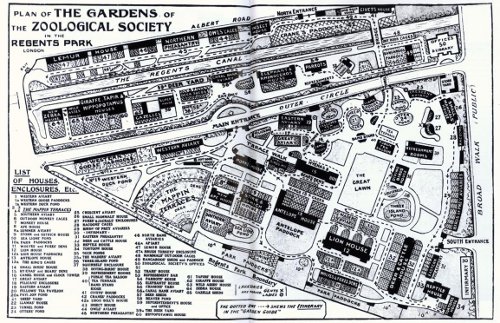
before researching all the buildings. …”
(Click to enlarge)
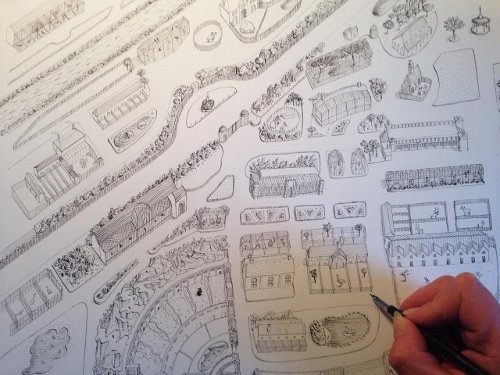
(Click to enlarge)
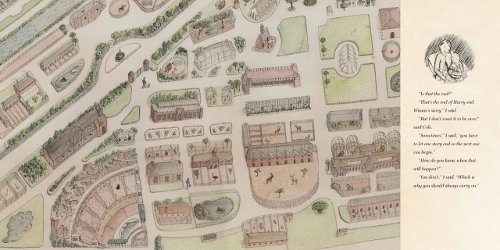
‘But I don’t want it to be over,’ said Cole. …”
(Click to enlarge)
Back at my desk, several things had me tied up in knots: the bird’s-eye view of the zoo, which involved researching period photographs of every building and cross-referencing those with a footprint map I had from 1913 (I would be looking at, say, the triumphal arch, which led to the giraffe’s exercise yard, trying to determine if there were two or three arches, as in the photographs I found it was always somewhat obscured by trees. Finally deciding on three, I was poised to draw it in, when I found in a tiny note elsewhere that the arch was demolished in 1911. Grr.); getting the train right (luckily, I share a studio with Brian Floca, who offered encouragement—I think I can, I think I can—and access to his library of train books); figuring out the parade of ships with the only existing color reference being a painting called Canada’s Answer [pictured below], an impressionistic interpretation of the crossing made some years after the event; and learning signal flags. (I snuck in a secret message.)

The other two big challenges were the jacket and how to transition from the book-ending of the bedtime story, to Harry and Winnie’s story, to Christopher Robin — and Cole’s interjections throughout. We knew all along that we all wanted the drawings with Cole to evoke E. H. Shepard’s pen and ink illustrations, but how to design the whole so that they could be interwoven seamlessly? It was trial and error and a true collaboration until we got it right.
As for the book jacket, I’ll let Saho talk about that, but I think I sent her a hundred cover drawings (or at least ten). We were down to the wire, through the wire, way beyond the wire, to the point where we sent out the F&Gs with a placeholder jacket. And at the last second, Saho pulled out this glorious surprise, which I love to bits. It makes me happy every time I see it.
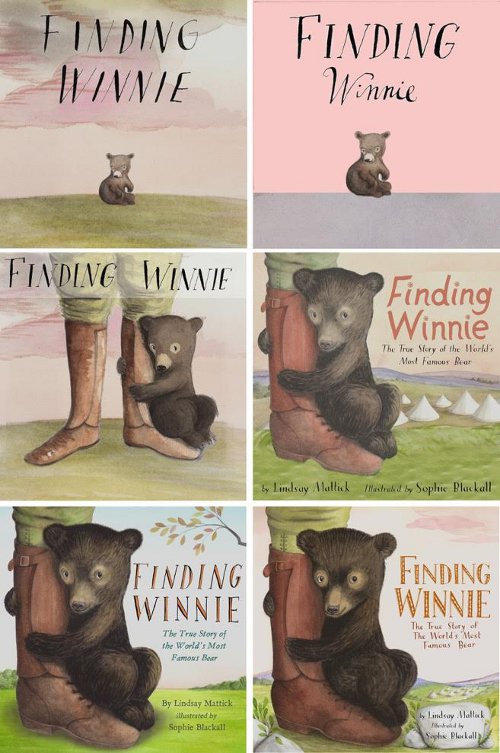
Susan: Finding the right cover kept me up at night, but such things often do. It took the whole team’s dedication to keep at it and find a way to make it truly sing, and I am so pleased with the result. It even looks smashing as a teeny tiny thumbnail online. A feat!
Also, not so surprisingly, I discovered that Sophie Blackall is a mad genius. Her process as an artist is akin to method acting. I fear she nearly bought a bear.

“the handsome pattern” on a 1950 edition of Winnie-the-Pooh
Saho: Keeping this book on the Fall ’15 list (along with other Fall titles) was the most challenging part of the process for me. We were moving offices, and I just stepped into the role of Art Director when I inherited this project from the former Art Director, Patti Ann Harris. Fortunately for us, the award-winning designer, Gail Doobinin, was designing the book at the time, and the project was well underway. This book is truly the team’s collective effort. Though we encountered some unexpected obstacles during the project, we managed to stay the course — and the result is a book that is beautiful and distinctive.
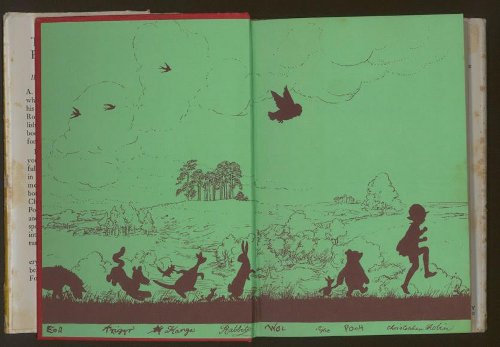
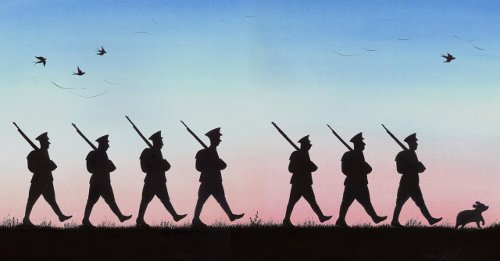
by E. H. Shepard’s endpapers.”
(Click to enlarge second image)
7-Imp: How did the finished book vary or evolve from your initial vision of the book?
Lindsay: Sophie! I remember camping out at bookstores and online for hours, looking at different illustrators. Finally, I came across Sophie’s book Missed Connections with its remarkable images. I went to the bookstore the next day to buy it, and when I read the introduction I knew Sophie would understand the heart of this story. I knew that she understood how a moment in time could change everything. And I knew she had the imagination to bring a single moment to life through an illustration. Sophie’s treatment has brought my story to life in a way I could never have imagined. Her work has captured the emotional moments in the book without sacrificing any of the historical accuracies, which she took great care to get right. I am still in awe and incredibly grateful she said yes!

(Click to enlarge)
Sophie: When I was pregnant, I spent hours imagining what my babies would be like, but once they were born I couldn’t remember my vision of them. They were just their dear, lumpy little selves. Similarly, I can’t remember my initial vision of Finding Winnie. I did, however, just read over my long email correspondence with Susan Rich. I have never worked this closely with an editor before, and it was an extraordinary experience. This book began with Lindsay’s family story (and what a story!), enriched by its framing as a conversation between parent and child. Susan edited it, which meant living with it, thinking about every nuanced word of it, seeing it before it existed. (I have said this before, but if ever an editor’s name ought to grace the cover of a book …)
And then, scene by scene and page by page, we talked it into being. Oh, and I did some drawing. And then Patti Ann and Gail and Saho lent expertise and ideas, and together we turned a pile of scribbled notes and sketches into a book.
I have culled a bunch of phrases from my emails to and from Susan. It more or less describes the arc of making Finding Winnie:
More sensible correspondence to come.
I’ve been looking deep into Winnie’s eyes. …
What a book we’re building! I am doing a jig.
I always have to remember that it’s not necessary to show everything.
Horses are more romantic and heroic and dashing than cows. …
Wait. … Did you already suggest this to me and I’m just feeding it back to you, pretending it’s my idea?
I write to you, cap in hand. …
… to ask for an extension.
It’s mostly working, I think, with the glaring exception of p. 14. …
I did so wish to be on time. Sorry.
The joy of painting, once the anxious sketching part is over, is a great incentive and reward.
We can go to final!
Crossing fingers, holding breath, muttering apologies. …
This is a beautiful jacket. Lethally appealing. Irresistible.
I think I’m almost pretty sure I like it quite a lot!
And there you go.
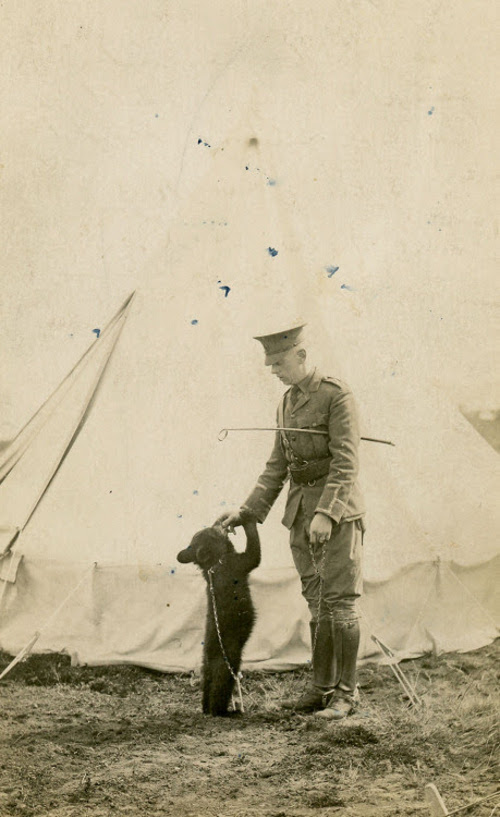
that inspired the statues in Winnipeg and London
Susan: After being submerged in the project’s details, the finished book feels almost unreal to me now — like stepping back from a tiled wall and discovering that it’s a beautiful mosaic.
The most delightful transformation was seeing Sophie’s art printed on paper. It was glorious to see sketches, glorious to see them turn into paintings, and then come together as a book in design, but something truly magical took place in the printing. It is a delicious book.

before handing it over to an expert”
Saho: Because I wasn’t involved in this project from the very beginning and also the layouts had already been created by the time I got involved, I didn’t have a specific vision for the finished book. However, the jacket still needed a lot of work, and it evolved quite a bit towards the end of the project. As the interior of this book came together, we thought the interior was so extraordinary that we wanted the cover to do the same.
While we all loved the image of Winnie hugging Harry’s boot, we were not sure if the background was as strong as it could be. The original background was very plain with just a suggestion of the ground. Then, we discussed adding grass, sky, branches, a butterfly, hills, soldiers’ tents. … I believe Sophie repainted the cover art at least three times! I echo Susan’s praise. Sophie is GENIUS!
After all those revisions, we revisited the cover yet one more time. This time, we decided to take a new approach and experimented with a bold graphic pattern and finally decided on the current diamond patterned background. We thought the diamond pattern was simple, yet eye-catching, and really helped Winnie and the boot pop.
I definitely speak for the group when I say that we are all very excited about how great this book turned out, and we have Sophie to thank for the stunning art and Lindsay for the incredible text — as well as Susan for her amazing edits. Team Winnie has a lot to be proud of!

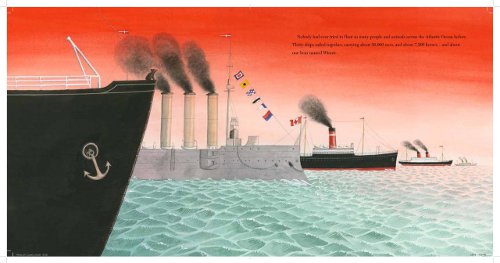
(Click to enlarge)
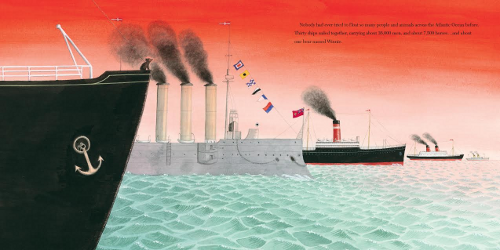
(Click to enlarge)
7-Imp: What’s next for you?
Lindsay: Last Fall, I worked with Ryerson University in Toronto to curate an incredible exhibition about my family history, called Remembering the Real Winnie: The World’s Most Famous Bear Turns 100. That exhibition will now travel to Winnipeg next Spring and, hopefully, soon to other cities around the world.
Besides Winnie, sharing family stories has always been something that’s particularly important to me. Having a son of my own has definitely cemented my desire to ensure the best of those stories and the characters behind them are passed on. Right now I am working on a new story to share another chapter in our family’s journey.
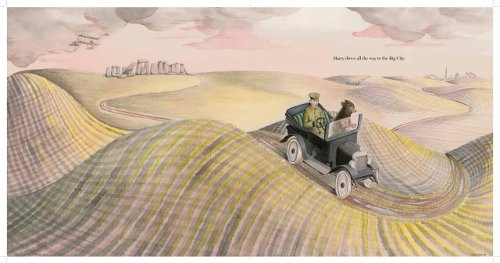
Sophie: “A few people have asked me what that tall building is doing sticking up from London’s famously low skyline. It’s a church steeple in a village
on the southwest outskirts of the city.”
(Click to enlarge)
Sophie: I’m putting finishing touches to a picture book called A Voyage in the Clouds, The (Mostly) True Story of the First International Flight by Balloon in 1785, written by Matthew Olshan (The Mighty Lalouche), which comes out next Fall from FSG. And I have a new series of chapter books with John Bemelmans Marciano, called The Witches of Benevento, coming from Viking next Spring!
Susan: It’s an exciting Fall! Besides Finding Winnie, I’m publishing One Today, Richard Blanco’s inaugural poem written for President Obama, magnificently illustrated by Dav Pilkey, who marks his return to picture books with this text. Later this month, the final book in Lemony Snicket’s spectacular All The Wrong Questions series will publish, which is bittersweet for me. This quartet of books is so gorgeously constructed, and it’s been a wonderful journey. The good news is that I am also just digging into a new Lemony Snicket picture book, so I will still have a good excuse to call Daniel Handler all the time.
Saho: We are in the midst of the Fall ’16 list. We have many exciting books on this list, and I can’t wait to share copies of those amazing books with readers next Fall!

Pictured immediately above: A photo of Winnie and Christopher Robin in 1925 at the zoo. A. A. Milne watches them from above.
FINDING WINNIE: THE TRUE STORY OF THE WORLD’S MOST FAMOUS BEAR. Copyright 2015 by Lindsay Mattick. Illustrations © 2015 by Sophie Blackall. Published by Little, Brown and Company, New York. All illustrations used by permission.
Photos of Ms. Mattick, Ms. Blackall, Ms. Rich, and Ms. Fujii used by their permissions.


Jules, I love these roundtable discussions!
What a fascinating post! Everything about this book touches my heart.
This is so fantastic! I love everything about Finding Winnie. Congratulations to the entire bookmaking team!
The roundtable discussion is a delightful format! I never knew W-T-P was based on this story – always love reading your posts! Am especially loving this post because we’ve just seen A.A. Milne’s original manuscript at Trinity College, Cambridge – housed in the fabulous Wren Library – beautiful!
[…] I ‘m also thrilled that Finding Winnie won the Caldecott Medal! Bear book bear book bear book!! I’m a longtime Sophie Blackall fan and I’m glad her supreme talent has finally been recognized in this way. What a year she’s had! Finding Winnie was written by Lindsay Mattick and you’ll find a wonderful round table discussion about this book (featuring author, illustrator, editor, book designer) at Seven Impossible Things Before Breakfast. […]
What an amazing story, and beautiful collaboration. Honors to Finding Winnie!!
[…] Seven Impossible Things Before Breakfast: One Picture-Book Roundtable Discussion Before Breakfast #4… Julie Danielson’s post discusses the process of creating Finding Winnie, the research, the stories and more. […]
[…] Weekly. Quill & Quire. School Library Journal. Blogs: Brain Pickings. Seven Impossible Things Before Breakfast. The Children’s War: A Guide to Books for Young Readers About World War II… and Other […]
I was wondering if permission to use the image of Saho Fujii could be given to the Society of Children Book Authors & Illustrators (Wisconsin Chapter)? Our blog is highlighting Saho before this year’s fall conference. Thanks for your consideration.
[…] [http://blaine.org/sevenimpossiblethings/?p=5167], or Sophie Blackall’s gorgeous water colors in Finding Winnie: The True Story of the World’s Most Famous Bear [http://blaine.org/sevenimpossiblethings/?p=3860]. Illustrators do painstaking research to get the […]
[…] a moment in Finding Winnie, written by Lindsay Mattick, when Cole says, “Is that the end?” And his mother says, […]